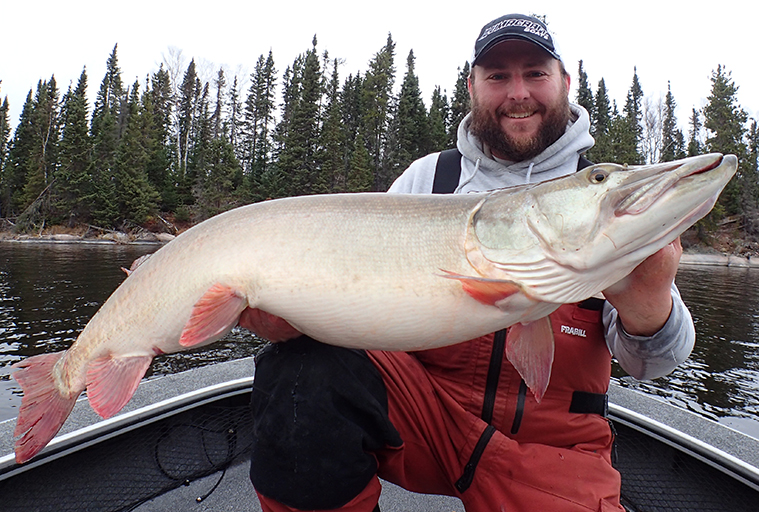
Muskie are known as the fish of 10,000 casts, and for good reason — they’re hard to catch. Even when things go well, there is a thin margin between being a “zero” and a “hero.” When catching just one fish is the measure of success, even a small mistake can lead to failure and heartbreak.
Every muskie angler has a story, or 10, about the one that got away. In my guiding career, I’ve seen it all: the good, the bad, the ugly, and everything in between.
Here are eight common mistakes. Don’t make them and you’ll catch more muskie.
1. The little things
Some of the biggest mistakes are made before the boat is even in the water. This is the case with terminal tackle. Cheap, poor-quality line, leaders, snaps, swivels, and split rings have the potential to separate you from the fish of a lifetime.
Using baits with dull hooks is another basic mistake I see all the time. Invest in a hook file and keep it nearby in the boat. All hooks need sharpening — just because a hook is new, doesn’t mean it’s sharp. Sharpen hooks ahead of time and again after catching a fish or making contact with anything that isn’t water. I’m adamant about having sharp hooks and I guarantee this small detail will catch you more fish.
Poor casting is another basic error that makes it difficult to catch muskie. Anglers who cast farther and more accurately will catch more fish, plain and simple. Know your equipment and practise with it ahead of time.
I recall guiding a group of three guys and on each of their first casts they were unable to reel in. The spool turned, but the line wouldn’t move. They all had brand new equipment that they hadn’t tested prior to heading out. Turns out there was no backing to grip the line on the spool and all three reels had to be stripped and re-spooled on the boat.
2. Boat control
Boat control is a critical aspect of muskie fishing, whether you’re casting, trolling, or jigging. Moving too fast or slow, and being too close or far from structure are common miscalculations that will cost you fish.
The biggest mistake I see people make is speeding past the hotspot or cutting too close to it. Slow down and keep your distance to effectively cover the structure without spooking fish. Conversely, speed up on sections of a spot that lack prime cover or structure, or skip them entirely.
Another way to improve boat control is to add waypoints on your chart. Drop-offs, weededges, boulder piles, underwater points, and more should be mapped out. This is especially true for spots that are away from shore and lack a visual reference. Advancements with AutoChart-enabled sonar/GPS units and GPS-controlled trolling motors are changing the way muskie anglers understand structure and how to control the boat for the best results.
There’s a mid-lake reef I like to fish that’s surrounded by a shallow, weedy skirt. The structure is quite large — about the length of a hockey rink -— and triangular in shape. Since none of the structure is visible above water, I rely on a set of waypoints to navigate around it and keep the boat in proper position to cast on top of it and to bring baits out across the drop-off. This particular spot has what I call “the hot corner” where 80% of the fish are raised and caught. I usually fish the entire spot, but I slow down and methodically cover the hot corner.
3. Your figure-8 stinks
Poor figure-8s are a dime a dozen. And that’s a big problem. A mistake in the figure-8 turns a potential catch into a lost opportunity. Anglers who are good at the maneuvre will catch upwards of 50% of their fish in the eight.

The worst oversight is not to make a figure-8 at all. At least make an “L” turn or a circle at the end of each cast while looking for follows. Every season I see multiple fish caught on the figure-8 that weren’t seen following. These blind attacks are thrilling to experience and won’t happen unless you take the time at the end of each cast.
A frequent flaw in figure-8 execution is not reeling up to the leader. Leaving excess line out results in sloppy figure-8s, as the bait doesn’t closely follow the rod tip. My rule of thumb is reel to within one inch of the end of the leader.
A second issue is poor transition into the figure-8. Stopping or pausing the bait between the cast and the figure-8 will lose the fish’s attention. A seamless transition from cast to figure-8 is a must.
Lastly, direction changes should be done with large turns — the bigger the better. A common mistake is making instant 180-degree direction changes — the back-and-forth syndrome. The best way to overcome this mistake is to fish with the longest rod possible. Nine and 10-foot rods are the new normal in muskie fishing, largely because they make figure-8s easier and more effective.
Becoming truly good at figure-8s is one of the hardest things to master in muskie fishing. It takes a lot of practice and the best learning comes from encounters with fish boatside.
4. Solunar shun
If you’re not a solunar believer, you should be. Start paying attention to solunar times and you’ll quickly realize that the correlation between increased activity levels, follows, and catches is real.
Technology makes it easy to follow solunar charts. OOD posts a solunar table online each month. And, check the browsing section of this and every issue of OOD for a print or digital version of upcoming solunar activity.
Pay attention to sunrise, sunset, moonrise, and moonset times, as well as “major” times when the moon is directly overhead or directly underfoot. At the minimum, be positioned on prime spots during these times, and, when possible, go back on previously raised fish during peak solunar times.
Every year, my regular clients book the July and August new-moon and full-moon days well in advance. They believe in the influence of sun and moon events, and so do I.
5. You’re not jigging
Jigging for muskies is not a new tactic, but its popularity has boomed in recent years. If jigging isn’t part of your repertoire, you’re missing out.
Much of the hype and success surrounding jigging muskies can be attributed to Windsor, Ontario-based guide and bait maker, Jon Bondy. Bondy put jigging for muskies on the map with his own product design on the Detroit River. The slender, heavy bait is ideal for fishing in current, but it works in non-current situations just as well.
My first experience with jigging for muskie happened while casting a rubber Bull Dawg bait. I noticed a large fish on bottom on my sonar and dropped the bait down. After a few vertical jigs, the fish hit. I lost it before the net, but the experience was game changing.
Most casting baits are effective for covering the top 10 feet of the water column. When muskies are utilizing deeper water, jigging is an effective way to contact them. Last fall during a trip on Lac Seul when casting wasn’t producing results, I decided to try jigging around a prominent point. With the boat over 40 feet of water, I dropped my bait down 25 feet and started to jig. Within 30 seconds, I felt a bump and set the hook. This time, 51 inches of muskie hit the net and reinforced the advantages of jigging.
6. Net job fail
You’ve done everything right and the muskie of your dreams is on the end of your line. You battle it like a pro to the side of the boat and your partner stabs at it with the net. There’s commotion in the water and the fish is splashing, half in, half out of the net. One more flick of the tail and the hooks pop free and you watch in disbelief as your prize swims away.
The first mistake is not having a net large enough to handle muskie. A true muskie-size net with a large hoop and deep bag made of thick-coated mesh is essential. A cradle isn’t a desirable option as it takes longer to land a muskie with a cradle, which gives the fish more time to get off.
Netting a muskie is like a dance between angler and netter. Both can make the other’s easier. Communication is key.
The angler’s job is to tell the net person they have a fish on, where to be in relation to the boat and the angler, and when to net the fish. It’s also the angler’s job to lead the muskie headfirst to the net. Attempting to net a muskie tail first is a cardinal error.
The net person should immediately grab the net — I keep mine easily accessible with the handle extended. They need to be ready when the fish is being led to the net. The moment of truth comes when the net person dips the net under the fish. Stabbing the net into the water in front of the fish will spook it. Instead, gently place the front of the hoop in the water ahead of time, and scoop under the fish, lifting once its body is inside the hoop. Avoid getting the hooks tangled in the mesh as the muskie’s head is coming into the net. This mistake almost always ends in a botched net job.
8. The mental game
Staying mentally tough may be the most difficult thing to master. The mistake is losing focus, motivation, and confidence, and then missing an opportunity to connect.
As a case in point, last summer I was fishing with some guys and it was tough going. We’d raised a few fish but hadn’t caught one in a couple of days. The sun was setting — prime time — as we pulled up to a new spot. One of the guys decided he was done for the day and took a seat. The rest of us kept fishing. As we cast our way along a weedy sandbar, another guy decided to take sunset pictures with his phone. Moments later, as my bait neared the boat, I see a follow and begin to figure-8. This muskie was “hot” and inhaled the bucktail on the first outside turn. A 50-incher, no less, that could have been caught by one of my partners had their mental game been stronger.
Muskie fishing is rarely easy, and the mental aspect of it is just as important as the physical. It’s a game of high highs and low lows, but staying confident and focused on the small details — like a figure-8 at the end of every cast — will pay off in the long run.
Lessons learned
Making mistakes is inevitable in the pursuit of muskie. Learning from them is part of the process that will turn muskie into the fish of fewer than 10,000 casts.
Originally published in the Fall 2018 edition of Ontario OUT of DOORS magazine


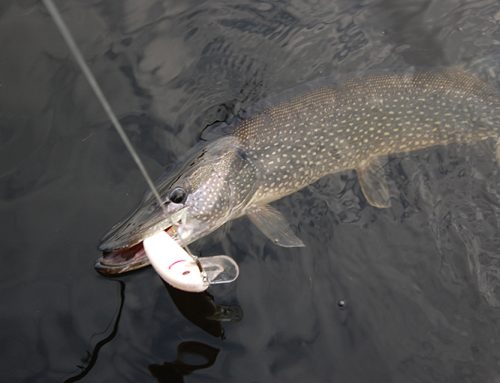
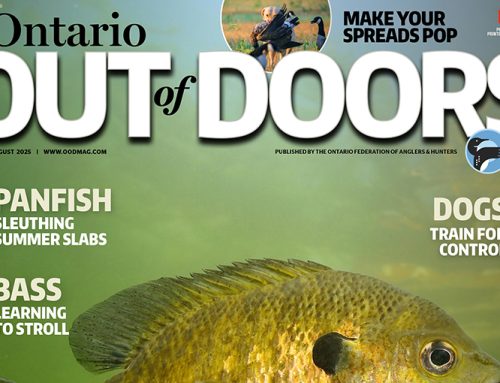
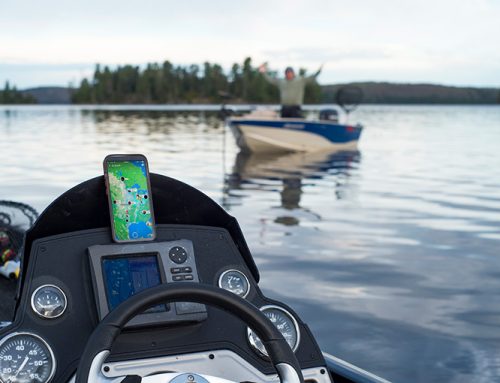
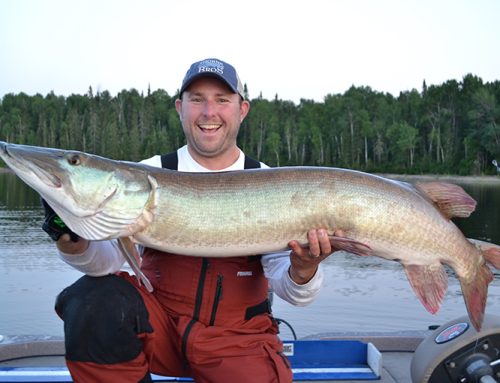
Leave A Comment